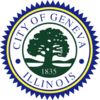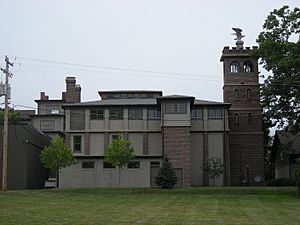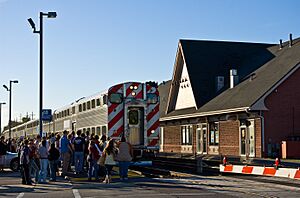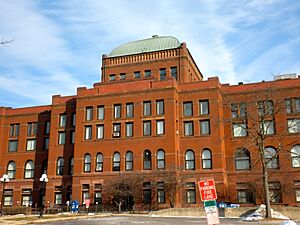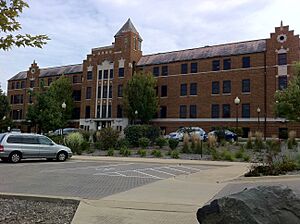Geneva, Illinois facts for kids
Quick facts for kids
Geneva, Illinois
|
|||
|---|---|---|---|
|
City
|
|||
| City of Geneva | |||
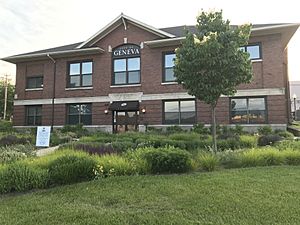
Geneva City Hall as viewed from Illinois Route 31
|
|||
|
|||
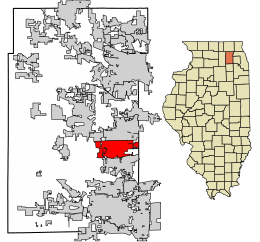
Location of Geneva in Kane County, Illinois
|
|||
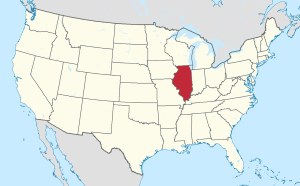
Location of Illinois
|
|||
| Country | United States | ||
| State | Illinois | ||
| County | Kane | ||
| Founded | 1835 | ||
| Incorporated as a village | 1867 | ||
| Incorporated as a city | 1887 | ||
| Government | |||
| • Type | Council-Manager | ||
| Area | |||
| • Total | 10.20 sq mi (26.43 km2) | ||
| • Land | 9.97 sq mi (25.81 km2) | ||
| • Water | 0.24 sq mi (0.62 km2) | ||
| Elevation | 738 ft (225 m) | ||
| Population
(2020)
|
|||
| • Total | 21,393 | ||
| • Density | 2,146.60/sq mi (828.84/km2) | ||
| Time zone | UTC-6 (CST) | ||
| • Summer (DST) | UTC-5 (CDT) | ||
| ZIP Code |
60134
|
||
| Area code(s) | 630 and 331 | ||
| FIPS code | 17-28872 | ||
| GNIS feature ID | 2394875 | ||
Geneva is a city in Kane County, Illinois, United States. It is the main city of the county. Geneva is located west of Chicago, in its suburbs. In 2020, about 21,393 people lived there.
Geneva is part of a "tri-city area" with St. Charles and Batavia. This area grew a lot from the late 1980s to the mid-2000s. Many people moved here as the Chicago suburbs expanded.
Geneva is a popular place for visitors. It sits along the beautiful Fox River. You can find many shops and restaurants there. The city has a large bike trail system. This includes parts of the Fox River Trail and the Illinois Prairie Path.
The Geneva History Center is in downtown Geneva. It helps preserve the city's past. You can also visit the Fabyan Windmill, an old Dutch windmill from the 1850s. In 2013, Bloomberg Businessweek magazine called Geneva the best place in Illinois to raise a child.
Contents
Where is Geneva?
Geneva is located at 41°53'9" North, 88°18'42" West. This is about 36 miles (58 km) west of downtown Chicago.
In 2010, Geneva covered about 9.994 square miles (25.88 km2) of land and water. Most of this area, about 9.75 square miles (25.25 km2), is land. The rest, about 0.244 square miles (0.63 km2), is water.
Geneva's Past: A Look Back
Geneva was first settled in the 1830s. It was on an important route from Chicago. Daniel Shaw Haight was the first European settler. In 1835, he sold his land to James and Charity Herrington. They helped create the town of Geneva.
In 1836, Geneva was chosen as the county seat. This happened because of a local person's connections with a politician from Cook County. The town was officially planned a year later. It was likely named after Geneva, New York. Before this, it was called LaFox, Big Spring, or Herrington's Ford.
A courthouse and jail were among the first big buildings. Geneva became a village in 1867. Its location on the Fox River offered many business chances. Early products made in Geneva included cheese, butter, milled grains, and packed meat.
In 1853, a railroad connection helped industries grow. By 1900, big employers included Appleton Manufacturing and Howell Foundry. This led to new projects like water pumping stations in 1896. Many Swedish immigrants moved to Geneva. By 1900, they made up half of the population. In 1901, Geneva connected to other Fox Valley towns by electric railway.
Historic Places to Visit
Fabyan Windmill
The Fabyan Windmill is a real, working Dutch windmill. It was built in the 1850s. You can find it in Geneva, just north of Batavia, off Route 25.
This smock mill is five stories tall and made of wood. It stands 68 feet (21 m) high. It was once part of Colonel George Fabyan's estate. Now, it belongs to the Kane County Forest Preserve District.
On June 4, 1979, the windmill was added to the National Register of Historic Places. It was called the Dutch Mill. The next year, it was featured on a U.S. postage stamp. It was part of a series called "Windmills USA." It was originally used to grind grains.
Riverbank Laboratories
Riverbank Acoustical Laboratories is a testing agency for sound. It was started by Wallace Clement Sabine in 1918. Colonel George Fabyan paid for and built the lab on his large Riverbank Estate in Geneva.
In its early days, the lab also had a team that solved secret codes. They worked on codes from old writings and enemy messages. The lab was added to the National Register of Historic Places in 2003.
Fabyan Villa
The Fabyan Villa Museum shows photos and items from the Fabyans' lives. It shares the story of the Riverbank Estate with visitors.
Sacred Heart Seminary Shrine
The Sacred Heart Seminary Shrine is a religious Chapel made of stone and mosaic. It is in Geneva, next to the Kane County Government Center. It's in the Gunnar Anderson Forest Preserve along the Fox River. It's near the old Sacred Heart Monastery.
The shrine was built in 1925. That's when some land along the river was sold to the Society of Jesus. The shrine is also known as the Geneva Grotto.
The beautiful mosaics on the shrine's sides have Latin words. Ignem veni mittere means "I have come to bring fire." Ego sum lux mundi means "I am the light of the world." The mosaics also show three arches with art of heaven and earth, a crucifix, and a lighthouse. The Latin phrases are from the New Testament. They describe Jesus. The altar has the letters "IHS," which are the first three letters of Jesus in Greek.
Sadly, the shrine has been damaged by vandals many times. On October 21, 2014, vandals threw white paint on the walls and mosaics. They also used spray paint to draw symbols. Parts of the stone structure were broken.
Elizabeth Place
Elizabeth Place, also called the Henry Bond Fargo House, is a historic home in Geneva. It is built in the Mission Revival style. Henry Bond Fargo owned the house. He was a well-known local businessman. He helped bring many early industries to Geneva. The house was added to the National Register of Historic Places in 2008.
Sports in Geneva
Geneva has been home to the Kane County Cougars baseball team since 1991. They play at Northwestern Medicine Field. The Cougars used to be part of Major League Baseball's minor league system. Now, they play in the American Association of Professional Baseball.
In 2015, the Chicago Steel hockey team moved to Geneva. They play in the United States Hockey League at Fox Valley Ice Arena. In 2023, the owners of the Chicago Blackhawks bought the Steel team.
Getting Around Geneva
Geneva is near several airports. These include Chicago Midway International Airport (MDW) and Chicago O'Hare International Airport (ORD). Dupage Airport (DPA) is also nearby.
Major highways run through the city. These include State Routes 25, 31, and 38. You can easily get to Interstate 88.
Bus Services
The Pace bus system serves Geneva. This system runs buses throughout Chicago's suburbs. Here are some bus routes in Geneva:
- Route 529 - Randall Rd / 5th Street
- Route 801 - Elgin / Geneva
- Route 802 - Aurora / St. Charles
Train Services
Geneva is part of the Chicago metropolitan area. It has a train station on the Union Pacific West Line. This is part of the Metra commuter rail system. Trains run often to downtown Chicago, which is 36 miles (58 km) away. The line also goes west to Elburn.
People of Geneva: Population Changes
| Historical population | |||
|---|---|---|---|
| Census | Pop. | %± | |
| 1860 | 997 | — | |
| 1880 | 1,239 | — | |
| 1890 | 1,692 | 36.6% | |
| 1900 | 2,446 | 44.6% | |
| 1910 | 3,006 | 22.9% | |
| 1920 | 3,327 | 10.7% | |
| 1930 | 4,607 | 38.5% | |
| 1940 | 4,101 | −11.0% | |
| 1950 | 5,139 | 25.3% | |
| 1960 | 7,646 | 48.8% | |
| 1970 | 9,049 | 18.3% | |
| 1980 | 9,881 | 9.2% | |
| 1990 | 12,617 | 27.7% | |
| 2000 | 19,515 | 54.7% | |
| 2010 | 21,495 | 10.1% | |
| 2020 | 21,393 | −0.5% | |
| U.S. Decennial Census | |||
The population of Geneva has grown a lot over the years. In 1860, there were less than 1,000 people. By 2020, the population was over 21,000.
Geneva's Population in 2020
| Race / Ethnicity (NH = Non-Hispanic) | Pop 2010 | Pop 2020 | % 2010 | % 2020 |
|---|---|---|---|---|
| White alone (NH) | 19,651 | 18,392 | 91.42% | 85.97% |
| Black or African American alone (NH) | 103 | 128 | 0.48% | 0.60% |
| Native American or Alaska Native alone (NH) | 3 | 10 | 0.01% | 0.05% |
| Asian alone (NH) | 461 | 485 | 2.14% | 2.27% |
| Pacific Islander alone (NH) | 3 | 3 | 0.01% | 0.01% |
| Some Other Race alone (NH) | 18 | 55 | 0.08% | 0.26% |
| Mixed race or Multiracial (NH) | 213 | 758 | 0.99% | 3.54% |
| Hispanic or Latino (any race) | 1,043 | 1,562 | 4.85% | 7.30% |
| Total | 21,495 | 21,393 | 100.00% | 100.00% |
The 2020 census showed that most people in Geneva are White. There are also growing numbers of Asian, Black, and people of mixed races. About 7.3% of the population is Hispanic or Latino.
Geneva's Population in 2010
In 2010, Geneva had 21,495 people living in 7,865 households. Most households (63.8%) were married couples. About 37.3% of households had children under 18.
The average household had 2.72 people. The average family had 3.18 people. The median age was 42.4 years. About 27% of the population was under 18.
In 2011, the average income for a household was $93,588. About 4.4% of the population lived below the poverty line. This included 4.5% of those under 18.
Schools in Geneva
Geneva School District 304 has several schools for different age groups.
Elementary Schools
- Harrison Street Elementary School (built in 1929)
- Williamsburg Elementary School (built in 2008)
- Heartland Elementary School (built in 2002)
- Mill Creek Elementary School (built in 1996)
- Fabyan Elementary School (built in 2008)
- Western Avenue Elementary School (built in 1964)
Middle Schools
- Geneva Middle School South (built in 1994)
- Geneva Middle School North (built in 2006)
High Schools
- Geneva High School (built in 1958)
Fun Events in Geneva
Geneva hosts several exciting events each year:
- Swedish Days
- Geneva Arts Fair
- Festival of the Vine
- Christmas Walk
- Geneva Concours d'Elegance
Movies Filmed in Geneva
Geneva has been a filming location for several movies:
- Harry and Tonto (1974): Parts were filmed outside the Geneva Courthouse and the Geneva Motel.
- Road to Perdition (2002): Starring Tom Hanks, this movie was filmed in downtown Geneva.
- Novocaine (2001): Starring Steve Martin, filmed at the Geneva Motel.
- The Resurrection of Gavin Stone (2017): Filmed in Geneva's downtown Dodson Place.
- The Christmas Thief (2021): Filmed in downtown Geneva.
Famous People from Geneva
Many notable people have connections to Geneva:
Academia and Science
- Elizebeth Smith Friedman (1892–1980), a famous code breaker and writer.
- Edmund Beecher Wilson (1856–1939), an American expert in genetics.
Arts
- Gower Champion (1919–1980), a theater director and dancer.
- Niykee Heaton (born 1994), a singer.
- Michael J. Nelson (born 1964), a comedian and writer.
- Joan Taylor (1929–2012), an actress.
Business
- George Fabyan, (1867–1936), a well-known businessman.
Media
- Sam Smith (born 1948), a sportswriter.
- Bob Woodward (born 1943), a famous investigative journalist.
Politics
- Steven Andersson (born 1964), a politician.
- James G. Fair (1831–1894), a businessman and politician.
Sports
- Ben Kanute (born 1992), a triathlete.
- Kevin McDowell (born 1992), a triathlete.
- Gabby Perea (born 2002), an artistic gymnast.
Sister City
Geneva has one sister city:
See also
 In Spanish: Geneva (Illinois) para niños
In Spanish: Geneva (Illinois) para niños



